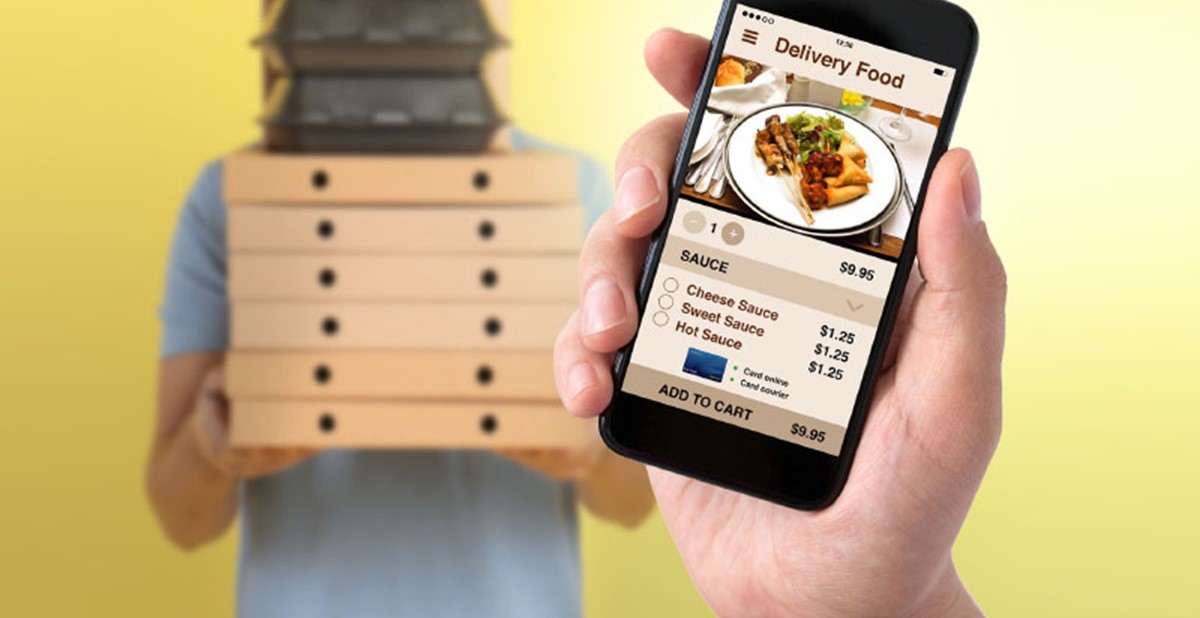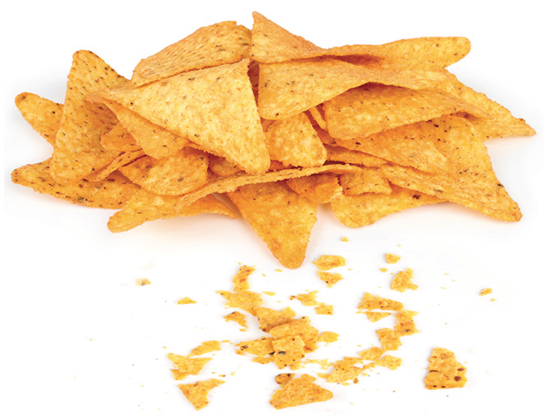Fast Forward: Fresh Out Of The Oven—Or The Truck Bed

Selling Point
Fresh Out Of The Oven—Or The Truck Bed
Want your favorite dish delivered fast? There’s more than one app for that.
If you work with clients in the restaurant or food industries, whether it’s meals, snacks or tasty treats for corporate gifting, the way that food is delivered is undergoing significant changes. This ongoing trend started with the burst of smartphone food-delivery applications, like Uber Eats, DoorDash, Postmates and GrubHub, which allow qualifying applicants to deliver food orders to customers without being employed by the eatery in question. These services replace the need for companies to hire their own delivery people, while broadening participating restaurants’ range of accessibility. In larger metropolitan areas, applicants are even able to deliver food via foot, scooter or bicycle if a vehicle is unavailable, providing jobs to those without personal transportation.
This has resulted in a staggering rise in food deliveries based on convenience and a growing preference for dining at home. According to Restaurant Business, 86 percent of consumers use food-delivery service apps on a monthly basis, while 33 percent are using these apps more than they did last year. According to Bloomberg, the number of food-delivery app downloads is up 380 percent compared to three years ago, and restaurant delivery sales are predicted to increase 48 percent over the next four years, generating $76 billion in revenue. The most sought-after delights? In a survey of 1,500 American diners conducted by USA Today, 28 percent said hamburgers, followed by chicken wings (27 percent), Mexican food (21 percent), barbecue (14 percent) and, of course, dessert (11 percent).But just as these tools are easing the process for consumers, they are stiffening competition among restaurants and delivery services. This year expect to see more businesses develop their own apps and delivery programs, as Panera Bread has done, which uses designated employees to deliver food. (In 2018, Panera doubled its digital sales to $2 billion, up from $1 billion in 2017, through its delivery app.) And although restaurant-specific apps could drive sales for eateries, it could lead to information overload because of the need to download apps unique to every venue. So, despite the technological infiltration and streamlining of food delivery, the process could revert to the traditional delivery service, only it’s facilitated by an app used to track food orders.
Some companies are also experimenting with presentation. Last year Dominos—a leader in innovative, forward-focused campaigns—and Ford partnered to launch self-driving pizza delivery cars in Las Vegas. Pizza Hut and Toyota raised the bar even higher, partnering to develop a prototype vehicle complete with a kitchen, allowing food to be prepared in transit. But no talk about delivery services would be complete without mention of drones—and they’re here. In 2016, Just Eat, a food-delivery app created in the UK, partnered with San Francisco, California-based Starship Technologies to develop a trial run for self-driving robots. So far, these machines have been used to deliver donuts and coffee to workers in California’s Silicon Valley and at universities nationwide. Uber is also slated to introduce delivery drones in 2021, but the technology is already underway in Reykjavik, Iceland, where the world’s first-ever drone delivery service was launched in 2017.
With the changes in delivery processes comes the need for greater organizational structure. This includes continued development of products like Google Home and Amazon’s Alexa, which can be used to order food, and the integration between technologies. Dominos invested in programming that enables customers to order food from their smart TV, computer, smartwatch and phone, which allows customers to communicate with “Dom”—Dominos’ chatbot—to place their order. The process is immensely simple—so simple, that customers can place their orders by exclusively using emojis. To accelerate delivery, San Francisco, Seattle and Chicago fast-food chains have been using the Spotlight Pickup System, created by restaurant technology provider eatsa. This system uses light-up shelf surfaces, referred to as “spots,” that can be virtually connected to deliveries or to-go orders. When a customer’s order is ready, the spot (shelf) will flash with their name.
With these changes under way, promotional products companies can use strategic foresight to prepare. As restaurants and food companies launch their own delivery systems, brand collateral can identify and promote independent delivery programs, including branded apparel for delivery people to sport during work hours or branded merch to advertise the company afterhours. Whether delivered by humans, robots or drones, food can be packaged in branded bags, such as eco-friendly, reusable, heat-retaining totes in company colors or with eye-catching logos. For meals prepared on-the-go, promotional products can be used to create a more personal experience, complete with social media-friendly photo opportunities to continue the conversation. Customers can be provided with keepsakes, like magnets or pins of menu favorites, or colorful tokens that can be exchanged for a free appetizer, dessert or delivery, depending on the campaign structure.
––––––––––––––––––––––––––––––––––––––––––––––––––––––––––––––––––––––
Market Share
Love Doritos, But Hate The Crumbs? Here’s A Resolution
Doritos Israel offers a promotional resolution to chip residue.
 Snacking on a bag of Doritos is a satisfying treat—until you look down and notice the growing mound of crumbs on your lap. It’s impossible to pinpoint how many of us have found ourselves in this exact scenario. When the chips are gone, and the delectable flavors have passed, you’re left with a mess. Tried-and-true solutions range from cleaning your hands with soap and water to licking your fingers clean. Yum! But recently, Doritos Israel launched a new, more convenient, resolution—a reusable Dorito’s bag made of terry cotton.
Snacking on a bag of Doritos is a satisfying treat—until you look down and notice the growing mound of crumbs on your lap. It’s impossible to pinpoint how many of us have found ourselves in this exact scenario. When the chips are gone, and the delectable flavors have passed, you’re left with a mess. Tried-and-true solutions range from cleaning your hands with soap and water to licking your fingers clean. Yum! But recently, Doritos Israel launched a new, more convenient, resolution—a reusable Dorito’s bag made of terry cotton.
Applauded for making the lives of Doritos-lovers easier, the bag acts as a packet for Doritos, safekeeping your serving, while doubling as a hand-wiping agent when it’s empty. The bag, which is machine-washable, was appropriately promoted by a video that showed Doritos fans eating the tasty treats and wiping dirty hands on clean pants, a couch, the dog and other unwarranted places. The bag was first promoted to gamers through a partnership between Doritos Israel and BUG, an Israeli video game retailer; a thoughtful move on Dorito’s part, as gamers are known for snacking more than the average person. In a Reuters study of 22 teenage boys of normal weight, they were found to consume 163 calories more on days when they played video games—which is just shy of the 200 calories that make up a small bag of Doritos.
The innovation was also marketed to gamers because greasy, crumb-speckled fingers don’t make for stability on the controller or TV remote. (It also causes frustration for the family member who’s next in line to watch TV.) According to the product announcement, advertising to this niche market was intended to sympathize (and gain brownie points) with the gaming community. It also shows a bold move on behalf of Doritos, which is bringing to light a common, albeit small problem experienced when eating their products. Releasing this product shows that Doritos not only understands the aggravation, but they care to resolve it—and make the savory experience more pleasurable for consumers.
––––––––––––––––––––––––––––––––––––––––––––––––––––––––––––––––––––––
Brandable
Tinder Feels The Promotional Love
A popular dating app launches a collection of branded merch.
 Online dating is ubiquitous. Dating apps? Even more so. Today there are far-reaching options for those seeking companionship or romance, from traditional web-based platforms like Match.com, eHarmony and OkCupid, to more specific, niche sites, like Equestrian Singles, Sea Captain Date and Farmers Only. Then there’s the slew of mobile apps, like Bumble, Coffee Meets Bagel and Happn, with more being introduced to market each year. But one of the most popular mobile dating apps, especially amongst Millennials, is Tinder.
Online dating is ubiquitous. Dating apps? Even more so. Today there are far-reaching options for those seeking companionship or romance, from traditional web-based platforms like Match.com, eHarmony and OkCupid, to more specific, niche sites, like Equestrian Singles, Sea Captain Date and Farmers Only. Then there’s the slew of mobile apps, like Bumble, Coffee Meets Bagel and Happn, with more being introduced to market each year. But one of the most popular mobile dating apps, especially amongst Millennials, is Tinder.
Tinder uses location-based technology to match users with potential suitors within a preset locality. Daters are invited to peruse a sea of suitors by swiping through profiles to find who or what they’re seeking. The rules are simple: if you like a profile, swipe right, and if you don’t, swipe left. If both users “like” each other, they are matched and allowed to message privately. If one or both users swipe left, no match is made, and the process continues. But according to the company website, many, many matches have been made thus far—more than 30 billion spanning 190 countries, with an average of one million dates each week. That’s sure a lot of mingling.
To celebrate its couples who found love and to spice things up for enthusiastic users, Tinder entered the promotional products space—just in time for Valentine’s Day. The company found its match in Stradivarius, a lifestyle brand based in Spain, collaborating to design a branded tee collection boasting flirty and comical sayings. “Love Me Tinder” is being marketed as the romantic option, while “I’m Your Right Swipe” is said to be about empowerment and “You looked taller on Tinder” underscores honesty; three characteristics that make for a quality relationship—and Tinder experience. The shirts are currently available in all Stradivarius stores and online.
––––––––––––––––––––––––––––––––––––––––––––––––––––––––––––––––––––––
Watercooler
Payless’s Palessi Publicity Stunt
What we can learn from the store’s faux luxury line.
It’s safe to say that Payless ShoeSource may have seen better days. The discount shoe store, which recently announced the closing of all its 2,100 locations across the United States and Puerto Rico this year, was once the go-to destination for busy moms, back-to-school wear and, of course, for scoring last-minute finds. The reasons? The rise in storefront costs, the shift to shopping online versus in-store and the disruption from web-based giants, like Amazon.
 To stay relevant during a time of radiant creativity, with new brands surfacing constantly, Payless decided to jump on board—by launching a faux luxury line. Dubbed Palessi after fictional Italian designer Bruno Palessi, Payless temporarily took over an Armani store in Santa Monica, California, where it announced the line during a two-day, invitation-only launch party. The company used a myriad of advertising tactics, like displaying the shoes on glass shelves or being worn by lavish gold mannequins, and the use of a sophisticated website and sleek Instagram page. The entry to the launch party, which was attended by fashion influencers, included velvet ropes and a camera crew.
To stay relevant during a time of radiant creativity, with new brands surfacing constantly, Payless decided to jump on board—by launching a faux luxury line. Dubbed Palessi after fictional Italian designer Bruno Palessi, Payless temporarily took over an Armani store in Santa Monica, California, where it announced the line during a two-day, invitation-only launch party. The company used a myriad of advertising tactics, like displaying the shoes on glass shelves or being worn by lavish gold mannequins, and the use of a sophisticated website and sleek Instagram page. The entry to the launch party, which was attended by fashion influencers, included velvet ropes and a camera crew.
Unbeknownst to attendees, the Palessi brand was selling Payless shoes, which typically ranged from $20 to $40, for $200 to $600. One guest at the party purchased a $36 pair for a whopping $640. When the event culminated, Payless revealed its secrets, returned the customers’ money and offered them a stipend to be featured in a Payless commercial. The plan behind the stunt was to remind customers that Payless shoes are so well crafted, they are indistinguishable from high-end brands—and are sold for a much lower price tag.
The reveal was met with mixed feelings. Some guests said it was crafty advertising for Payless to use its own resources, essentially, to leverage exposure. Others claimed it was wrong for Payless to deceive the influencers who attended the party. But all in all, Payless’s stunt revealed the power of marketing. Although the company’s efforts didn’t necessarily pay off in the long term, the event generated media coverage and indicated the effectiveness of staging on consumers’ perception. The effort was so effective that some influencers were willing to pay 17 times the original price—an impressive, and perhaps unexpected, outcome.
––––––––––––––––––––––––––––––––––––––––––––––––––––––––––––––––––––––
Five Minutes With
Allen Schweyer, chief academic advisor of the Incentive Research Foundation
 Employee Engagement
Employee Engagement
Allen Schweyer explains the significance of engaged workers in the success of any organization.
PPB What exactly is employee engagement? How would you describe the behaviors of an employee who is considered “engaged?”
Schweyer Employee engagement might be best defined in contrast to employee satisfaction. Satisfied employees are typically content with pay, work conditions and benefits. Good pay and benefits will attract people to organizations. Engaged employees are inspired. They identify and align with the organization’s goals and mission. They derive purpose from their work. They go beyond simply doing what’s required of their job, they devote extra ‘discretionary’ effort. They are more likely to commit to their firm and remain with it longer than disengaged or merely satisfied employees.
PPB How can high employee engagement benefit both the organizations and the employees?
Schweyer Organizations benefit in a number of ways. As above, they benefit from employees’ discretionary effort and much lower turnover. They also benefit because engaged employees are more likely to volunteer their ideas, help their colleagues, share information and embrace change initiatives. Engaged employees are better corporate citizens, they help create a ‘talent culture’ that, in turn, engages other employees and makes it easier to recruit other top talent. Engaged employees benefit from greater enjoyment and fulfillment from their work. They are also more likely to progress and achieve their career aspirations. Moreover, engagement at work spills over into engagement outside of work, improving life and relationships overall.
PPB Can you share a bit about the new research published by the Incentive Research Foundation about the psychological benefits of employee engagement?
Schweyer The IRF conducts and supports a range of research relevant to employee engagement. Specifically, the IRF focuses on one of the key drivers of employee engagement: recognition. Recent research demonstrates the clear link between the use of incentives, rewards and recognition, and enhancement of intrinsic motivation in employees. In other words, well-selected incentive, rewards and even simple thank-you’s reinforce the condition that engages employees.
PPB Can you share about the five types of psychological benefits, and how employers can engage all five?
Schweyer Psychological benefits of employee engagement include feelings of purpose and meaning, which satisfy employees’ higher order needs for self-actualization. Relatedness is another benefit, which fulfills employees’ need to belong and feel connected to others at work. Mastery, which gives employees a feeling of competence and confidence. Autonomy provides employees with agency choice over their work and how to perform it, and finally, inclusion and respect, which satisfy employees’ need to be heard and to contribute.
PPB What are some examples of successful engagement initiatives and programs that you’re familiar with?
Schweyer Google’s ‘Project Oxygen’ comes to mind. Here, the company studied the attributes of successful frontline managers. It determined the elements that made managers into the type of leaders that inspire employee engagement in their teams. This is just one of several initiatives Google has launched to drive higher engagement. More information on the study is available at www.culturesummit.co/articles/employee-engagement-best-practices.
PPB How can businesses determine whether a new employee engagement initiative is working?
Schweyer Leaders should establish a benchmark for employee engagement first, using a survey, and repeat the survey at least annually. As initiatives are launched, their impact can be measured in changes on the survey. Some firms are moving toward other indicators, such as brief daily polls, and/or technologies that measure employee job-seeking activity. Another good indicator is a change in attrition. If attrition goes down after an engagement initiative, it is a reasonable indicator that the program is working.
PPB Have you noticed a change in the emphasis on employee engagement in recent years? If so, what do you think is driving this change?
Schweyer Use of the term ‘employee engagement’ accelerated years ago. But emphasis on engagement, unfortunately, tends to rise and fall somewhat with the economy. Over the past few years, it has risen again to the top of the agenda in many firms as a means to both retain employees and gain greater productivity. The change is driven by a tight market for talent, the high costs of attrition and an ultra-competitive business environment.
The Incentive Research Foundation (IRF) is a nonprofit foundation that funds research studies and develops products serving all segments of the global incentive industry. IRF focuses its efforts on research that underscores the value and power of incentive and motivational programs.
––––––––––––––––––––––––––––––––––––––––––––––––––––––––––––––––––––––
Danielle Renda is associate editor of PPB.

